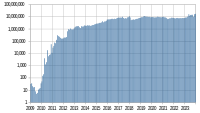
Photo from wikipedia
As an emerging digital asset, Bitcoin has been traded for more than a decade, reaching an impressively high market capitalization and continuing to expand its volume of trading at a… Click to show full abstract
As an emerging digital asset, Bitcoin has been traded for more than a decade, reaching an impressively high market capitalization and continuing to expand its volume of trading at a rapid pace. Many countries have legalized or are considering legalizing a trading platform for this asset, and a set of companies worldwide accept it as a medium of exchange. As a result of this expansion, many studies in finance literature have focused on studying the efficiency of this cryptocurrency. In line with this literature, this paper investigates, using the abnormal returns and abnormal trading volumes methodologies, the dynamics of investors’ reaction to the arrival of unexpected favorable and unfavorable information regarding the Bitcoin market in the context of the three famous hypotheses: the overreaction, the uncertain information, and the efficient market hypotheses. Overall, we find evidence confirming that the Bitcoin market tends to mature over time. More precisely, over the entire analyzed period, investors behave in accordance with the predictions of the uncertain information hypothesis when positive and negative events occur. However, splitting the timespan into sub-periods provides interesting insights. Remarkably in this respect is the fact that starting with the second sub-period, the response of investors in the Bitcoin market supports, in a moderate manner, the postulate of the efficient market hypothesis when favorable events are addressed. Moreover, our findings reveal that during the pandemic period, the efficiency of Bitcoin has increased, thus turning this stressful period into an advantage for this cryptocurrency. This improved market efficiency is also supported by the abnormal trading volume analysis.
Journal Title: PLoS ONE
Year Published: 2022
Link to full text (if available)
Share on Social Media: Sign Up to like & get
recommendations!